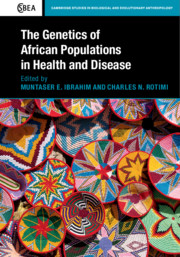Book contents
- The Genetics of African Populations in Health and Disease
- Cambridge Studies in Biological and Evolutionary Anthropology
- The Genetics of African Populations in Health and Disease
- Copyright page
- Contents
- Contributors
- 1 Reflections on Conceptualizing Africa for Biological Studies with a Historical Component
- 2 History and Genetics in Africa
- 3 Disease, Selection, and Evolution in the African Landscape
- 4 Genetic Susceptibility to Visceral Leishmaniasis
- 5 Genetics of Infection in Sub-Saharan Africa
- 6 Pharmacogenomics and Infectious Diseases in Africa
- 7 A Glimpse into Pharmacogenomics in Africa
- 8 Genomics of Cardiometabolic Disorders in Sub-Saharan Africa
- 9 Breast Cancer in African Populations
- 10 Sociobiological Transition and Cancer
- 11 The Genetic Epidemiology of Orphan Diseases in North Africa
- 12 Birth Defects and Genetic Disease in Sub-Saharan Africa
- 13 Neurogenetic Disorders in Africa: Hereditary Spastic Paraplegia
- 14 Enabling Genomic Revolution in Africa
- Index
- References
2 - History and Genetics in Africa
Multidisciplinary Efforts
Published online by Cambridge University Press: 02 December 2019
- The Genetics of African Populations in Health and Disease
- Cambridge Studies in Biological and Evolutionary Anthropology
- The Genetics of African Populations in Health and Disease
- Copyright page
- Contents
- Contributors
- 1 Reflections on Conceptualizing Africa for Biological Studies with a Historical Component
- 2 History and Genetics in Africa
- 3 Disease, Selection, and Evolution in the African Landscape
- 4 Genetic Susceptibility to Visceral Leishmaniasis
- 5 Genetics of Infection in Sub-Saharan Africa
- 6 Pharmacogenomics and Infectious Diseases in Africa
- 7 A Glimpse into Pharmacogenomics in Africa
- 8 Genomics of Cardiometabolic Disorders in Sub-Saharan Africa
- 9 Breast Cancer in African Populations
- 10 Sociobiological Transition and Cancer
- 11 The Genetic Epidemiology of Orphan Diseases in North Africa
- 12 Birth Defects and Genetic Disease in Sub-Saharan Africa
- 13 Neurogenetic Disorders in Africa: Hereditary Spastic Paraplegia
- 14 Enabling Genomic Revolution in Africa
- Index
- References
Summary
Population studies that integrate genetics and aspects of culture in order to examine historical topics, or that use history or archaeology to help explain geographical patterns of genetic variation, have become more common in the literature. This body of work includes, but is not restricted to, the exploration of the relationship between patterns of genetic and linguistic differentiation, genetic variation in societies defined as politically simple or complex (even if they fall within the boundaries of states), and the possible association of genetic variation and the spread of cultural innovations such as the practice of plant and animal domestication. In all of these examples, geography and/or migration are major background themes because genes and aspects of culture are evaluated in terms of movement across space and/or time. Such work at its best in theory requires the effective use of historical linguistics, archaeology, ethnology, and written and oral historical texts in the context of population genetics data and theory. The term “population history” is not necessarily used consistently. The subject – “population” – may vary in its referent. Genetics and other fields would likely be better understood as having different roles to play in any writing of history from any region in the world. This leads to the question of what kind of data/evidence should lead the construction of a historical narrative, and when: This interesting question may be obvious in some cases, but not so obvious in others. Ideas about identity and whether culture, with or without language, may be more important than ancestry or phenotype in a narrative are points of contestation. In some models of research, genetic profiles could be interpreted in terms of ideas about the geographical origins of genes found in a population, which may give us a “history” of interactions of gene bearers, but it must be kept in mind that gene history is not the same as population or culture history: The mediators (i.e., “gene bearers”) of particular genes may not be the population, or from the region, of the ultimate origin of the genes. Time and geography are important. The genetic profile at one time or place for a society does not necessarily tell you about its population’s total cultural or biological “origins” – a notion that is not always used consistently or clearly: Different fields may bring different assumptions to the analysis of the data. It also does not tell you about its descendants. Although statistical modeling might be helpful, it is clear that it has real limits: Statistics, Bayesian or otherwise, could not have predicted the change in population in North and South America, or the subsequent history that led to numerous “admixed” communities. (We have to remember that “admixture” is not a new phenomenon.) It is important to say that “genetic history” is not the same as social or political history, and to ask how or if genetics would help understand various historical events versus the other data. This chapter will explore some concepts related to these issues.
- Type
- Chapter
- Information
- Publisher: Cambridge University PressPrint publication year: 2019



